- Introduction
- Context
- Life
- Thought
-
Works
- The multilingual nature of Llull's works
- Llull and the catalan language
- Diffusion and preservation
- Book of Contemplation
- Book of the Gentile
- Book of the Order of Chivalry
- Doctrina pueril
- Romance of Evast and Blaquerna
- Book of the Lover and the Beloved
- Ars demonstrativa
- Felix or the Book of Wonders
- Book of the Beasts
- Desconhort
- Tree of Science
- Exemplary Tree
- Cant de Ramon
- Rhetorica nova
- Logica nova
- Liber de fine
- Ars brevis
- Phantasticus
- Ars brevis praedicationis
- Gallery of images
- Database / Dictionary
The new Science
Llull’s Tractat d’astronomia is called Nova astronomia or Novus tractatus de astronomia in certain Latin manuscripts. We also find the adjective ‘novus/nova’ in the titles of the Liber de geometria nova et compendiosa and of the Liber novus physicorum et compendiosus. There exist also, in the realms of letters and of philosophy, a Rhetorica nova and even a Logica nova. This ‘novelty’ was the result of modifications carried out by Llull upon the principles of the sciences he was considering at the time these were incorporated into his Art.
In open conflict with the theory of science of scholastic times, Ramon raised the study of natural phenomena to the category of the strictly demonstrative and deductive sciences. This operation should be assessed more thoroughly from the viewpoint of Llull’s logical mechanisms for demonstration, which do not coincide with those put forward by Aristotle. Thus the Logica novapresented a higher concept of demonstration ‘per aequiparantiam’ [‘by equiparation/equivalance’], applicable to the principles of Figure A (that is to say, to the sphere of theology), alongside demonstrations ‘according to the cause’ (demonstration ‘propter quid’) - in practice, the only generally accepted form of demonstration -, and demonstrations ‘according to the effect’ (demonstration ‘quia’) - to which a secondary role was assigned.

The ‘novelty’ of Llull’s astronomy lay in the method of ‘devictio’ [‘conquering’], which enabled one to calculate, without tables or astrolabe, the relations between the planets and the signs of the zodiac, which provided the basis for interpreting the influences of celestial bodies upon the world. These influences were of great importance to medical practice. Llull also reformulated the principles of medicine even though his works concerning this discipline did not carry the adjective ‘new’ in their titles. In any case the Principles of Medicine present the ‘old’ (Hypocratico-Galenic) principles of this science alongside those derived from the Art
Llull’s ‘new’ geometry was symbolic and instrumental to metaphysical and theological reflection. The Full Figure, for example, represented a concentric circle, square and triangle, supposedly of equal areas, which signified the correlation of the three, divine, physical, and rational, worlds. It could also be said that the Tree of science was a ‘new’ encyclopedia, because it provided a complete description of knowledge, a ‘scientia universalis’, governed by the organising principles of the system and not by a catalogue of the individual parts of which it was composed.